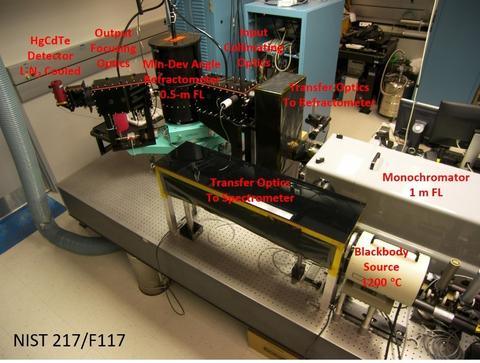Summary
This program is directed towards characterizing the refractive index and its wavelength dependence at diffraction-limited uncertainty, of optical materials of technological importance and scientific interest, for wavelengths in the range (0.12 μm – 15 μm).
Description

Fig. 1. NIST Minimum Deviation Refractometer System.
The real part of the refractive index, its wavelength dispersion, and its temperature dependence are the key parameters for the design of refractive optical elements for optical systems. The demands for continually improved precision of optical instruments has driven a need for increasingly accurate values of index of refraction of the optical materials used, well beyond the established values in the literature. This has been particularly true for leading-edge semiconductor lithography tools operating at ultraviolet wavelengths and for infrared imaging systems operating at near-to-mid-infrared wavelengths. The primary mission of this project is to update for the optical communities the refractive index values for the optical materials used in key optical technologies, at the accuracy needed now and in the foreseeable future.
To this end we have been making index measurements of key optical materials with diffraction-limited uncertainties for the full transmissive wavelength range, within the range (0.12 μm – 15 μm). This has required the development of a unique minimum-deviation-angle refractometry system, operating in this range, designed to achieve index accuracies at the limit achievable by diffraction for the sample size, e.g., routinely below 1x10-6 at visible and ultraviolet wavelengths. These measurements include the temperature dependence of the refractive index through the range. The system is shown in the photo in Fig 1.
This project is presently focused on using the facility to improve the accuracy in the literature (generally by more than an order of magnitude) of the index values of technologically important IR materials, enabling more advanced IR optics design. The project also provides index measurements on customer supplied materials, as requested.
A discussion of the refractometry system and its capabilities is contained in the Minimum-Deviation-Angle Refractometry System.

